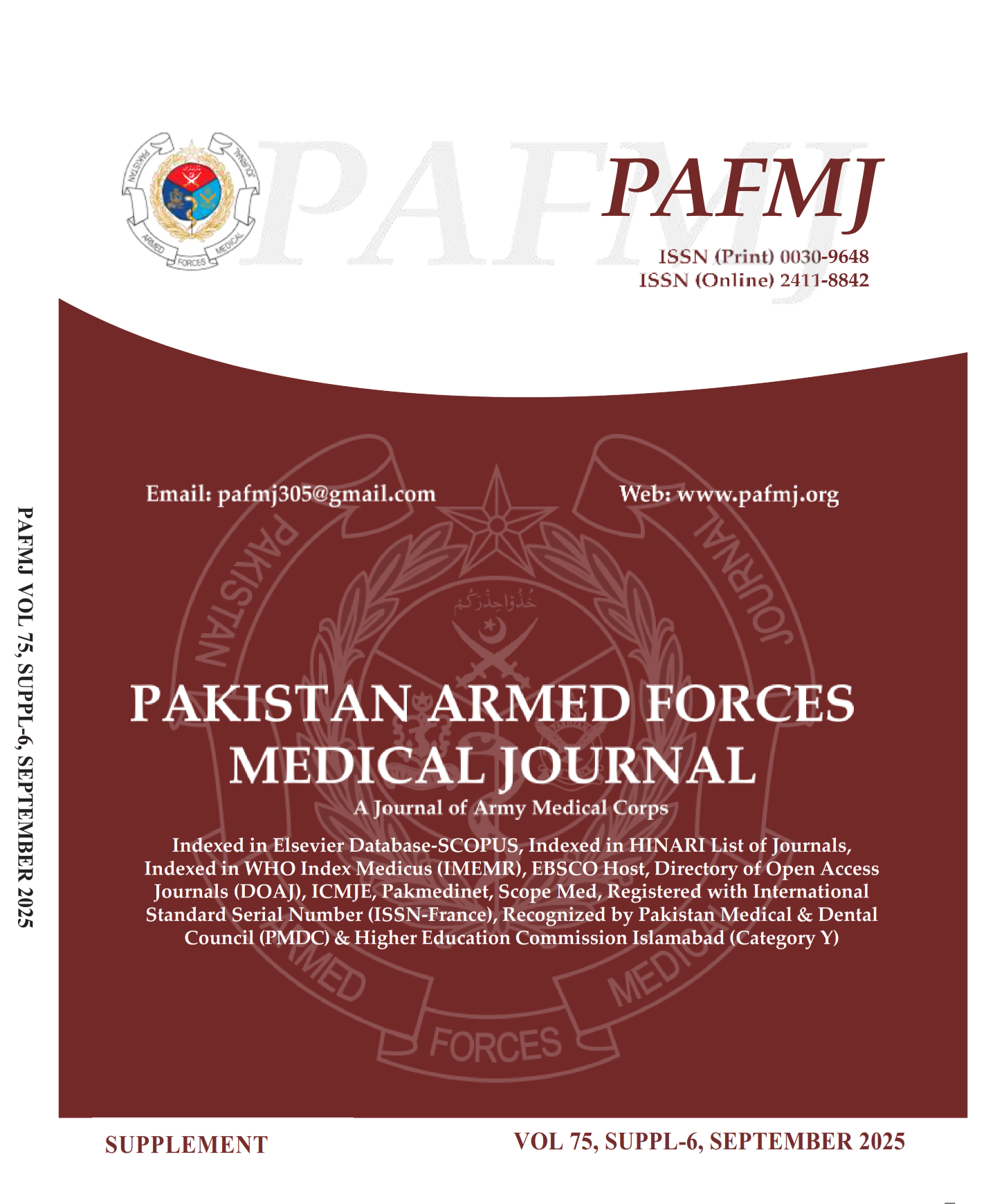Determination of Blood Culture Contamination Rate at a Tertiary Care Hospital
DOI:
https://doi.org/10.51253/pafmj.v75iSUPPL-6.10112Keywords:
Blood culture, Contamination rate, Coagulase negative staphylococci, Bloodstream infectionsAbstract
Objective: To determine bacterial contamination rates in blood culture specimens received at Microbiology Department, Armed Forces Institute of Pathology, Rawalpindi Pakistan.
Study Design: Cross-sectional study.
Place & Duration of Study: Department of Microbiology, Armed Forces Institute of Pathology & Combined Military Hospital, Rawalpindi Pakistan, from Aug to Dec 2022.
Methodology: All the blood culture samples signaled positive on automated blood culture system, were sub cultured on appropriate media for identification of isolates. The skin flora was labeled as contaminant, if fulfilled the criteria as per operational definition. The clinical history and other required data was incorporated in Excel sheet and was analyzed.
Results: The total number of blood cultures received was 1816, of which 425 were signaled positive by the system. Of the total blood cultures, 260(14%) were identified as contaminants including Coagulase negative Staphylococcus (83.%), Corynebacterium spp. (10.4%), Bacillus spp. (4.2%) and Micrococcus (2.3%). These organisms were identified as contaminants after thorough evaluation of the clinical condition of the patients. The highest blood culture contamination rate (23%) was observed in samples received from neonatal Intensive Care Unit (ICU), followed by paediatric ICU& paediatric wards.
Conclusion: In our study the overall blood culture contamination rates are found to be higher than internationally accepted rate with the highest contamination rates are found to be in the neonatal ICU and paediatric wards. Therefore, comprehensive plan of training the relevant healthcare workers (HCW) is recommended with strict monitoring to minimize the blood culture contamination rate to the internationally acceptable level.
Downloads
References
1. Viscoli C. Bloodstream Infections: The peak of the iceberg. Virulence 2016; 7(3): 248–251.
https://doi.org/10.1080/21505594.2016.1152440
2. Hattori H, Maeda M, Nagatomo Y, Takuma T, Niki Y, Naito Y, et al. Epidemiology and risk factors for mortality in bloodstream infections: A single-center retrospective study in Japan. Am J Infect Control 2018; 46(12): 75–79.
https://doi.org/10.1016/j.ajic.2018.06.019
3. Goto M, Al-Hasan MN. Overall burden of bloodstream infection and nosocomial bloodstream infection in North America and Europe. Clin Microbiol Infect 2013: 19(6): 501–509.
https://doi.org/10.1111/1469-0691.12195
4. Selek MB, Bektore B, Kula Atik T, Baylan O, Ozyurt M. Retrospective Evaluation of Aerobic Blood Culture Contamination Rates in a Tertiary Care Hospital in One Year. Erciyes Tıp Dergisi Erciyes Med J 2015; 36: 152–155.
https://doi.org/10.5152/etd.2014.8035
5. Hemeg HA, Almutairi AZ, Alharbi NL, Alenezi RF, Alturkostani MA, Ozbak HA et al., Blood culture contamination in a tertiary care hospital of Saudi Arabia. A one-year study. Saudi Med J 2020; 41: 508–515.
https://doi.org/10.15537/smj.2020.5.25052
6. Krause RC. Blood culture contamination in the departments of paediatrics and child health at two tertiary training hospitals in central South Africa. South Afr Med J 2022; 112(2): 13503.
7. Alnami AY, Aljasser AA, Almousa RM, Torchyan AA, BinSaeed AA, Al-Hazmi et al. Rate of blood culture contamination in a teaching hospital: A single center study. J Taibah Univ Med Sci 2015; 10: 432–436. https://doi.org/10.1016/j.jtumed.2015.08.002
8. Tenderenda A, Łysakowska M, Dargiewicz R, Gawron-Skarbek A. Blood Culture Contamination: A Single General Hospital Experience of 2-Year Retrospective Study. Int. J. Environ. Res. Public. Health 2022; 19: 3009.
https://doi.org/10.3390/ijerph19053009
9. Hughes JA, Cabilan CJ, Williams J, Ray M, Coyer F. The effectiveness of interventions to reduce peripheral blood culture contamination in acute care: a systematic review protocol. Syst Rev. 2018; 7(1): 216. doi: 10.1186/s13643-018-0877-4. PMID: 30497526; PMCID: PMC6267024
10. Sacchetti B, Travis J, Steed LL, Webb G. Identification of the main contributors to blood culture contamination at a tertiary care academic medical center. Infect Prev Pract 2022; 4: 100219. https://doi.org/10.1016/j.infpip.2022.100219
11. Doern GV, Carroll KC, Diekema DJ, Garey KW, Rupp ME, Weinstein MP, et al. Practical Guidance for Clinical Microbiology Laboratories: A Comprehensive Update on the Problem of Blood Culture Contamination and a Discussion of Methods for Addressing the Problem. Clin Microbiol Rev 2019; 33: e00009-19.
https://doi.org/10.1128/CMR.00009-19
12. Shaheen N, Zeeshan M, Fasih N, Farooqi J, Jabeen K, Irfan S et al. Efforts to improve diagnosis of bacteraemia by reducing blood culture contamination in an emergency department: strategies and outcome. J Pak Med Assoc 2020; 70(5): 835-839.
https://doi.org/10.5455/JPMA.12462. PMID: 32400737.
13. Towns ML, Jarvis WR, Hsueh PR. Guidelines on blood cultures. J Microbiol Immunol Infect 2010; 43(4): 347-9.
https://doi.org/10.1016/S1684-1182(10)60054-0
14. Asante J, Amoako DG, Abia ALK, Somboro AM, Govinden U, Bester LA, et al. Review of Clinically and Epidemiologically Relevant Coagulase-Negative Staphylococci in Africa. Microb Drug Resist 2020; 26: 951–970.
https://doi.org/10.1089/mdr.2019.0381
15. Naing L, Nordin RB, Abdul Rahman, et al. Sample size calculation for prevalence studies using Scalex and ScalaR calculators. BMC Med Res Methodol 2022; 22(1):1–8.
https://doi.org/10.1186/s12874-022-01694-7
16. Gunvanti R, Lakshmi JT, Ariyanachi K, Saranya M, Kamlakar S, Sakthivadivel V etal. Blood Culture Contamination Rate as a Quality Indicator - a Prospective Observational Study. Maedica 2022; 17: 311–316.
https://doi.org/10.26574/maedica.2022.17.2.311
17. Sallam L, Kaabia N, Aidaroos A, Odayani A. Rate of Contaminated Blood Cultures (CBCs) at Tertiary Healthcare Setting, Saudi Arabia. Acta Sci Med Sci 2021; 5: 62–66.
https://doi.org/10.31080/ASMS.2020.05.0869
18. Chukwuemeka IK, Samuel Y. Quality assurance in blood culture: A retrospective study of blood culture contamination rate in a tertiary hospital in Nigeria. Niger Med J 2014; 55(3): 201-3. https://doi.org/10.4103/0300-1652.132038
19. Lalezari A, Cohen MJ, Svinik O, Tel-Zur O, Sinvani S, Al-Dayem YA, et al. A simplified blood culture sampling protocol for reducing contamination and costs: a randomized controlled trial 2020; 26(4): 470-474. https://doi.org/10.1016/j.cmi.2019.09.005
20. Yunus N, Batool A, Yaqoob A, Khawaja A, Lone D, Ahmed Q et al. Rate of Blood Culture Contamination as an Indicator of Quality of patient care - a retrospective study. P J M H S 2021; 15 (4): 729-731.
21. Min H, Park CS, Kim DS, Kim KH. Blood culture contamination in hospitalized pediatric patients: a single institution experience. Korean J Pediatr 2014; 57(4): 178-85.
Downloads
Published
Issue
Section
License
Copyright (c) 2025 Sakeenah Hussain Naqvi, Eisha Aiman, Irfan Ali Mirza

This work is licensed under a Creative Commons Attribution-NonCommercial 4.0 International License.















